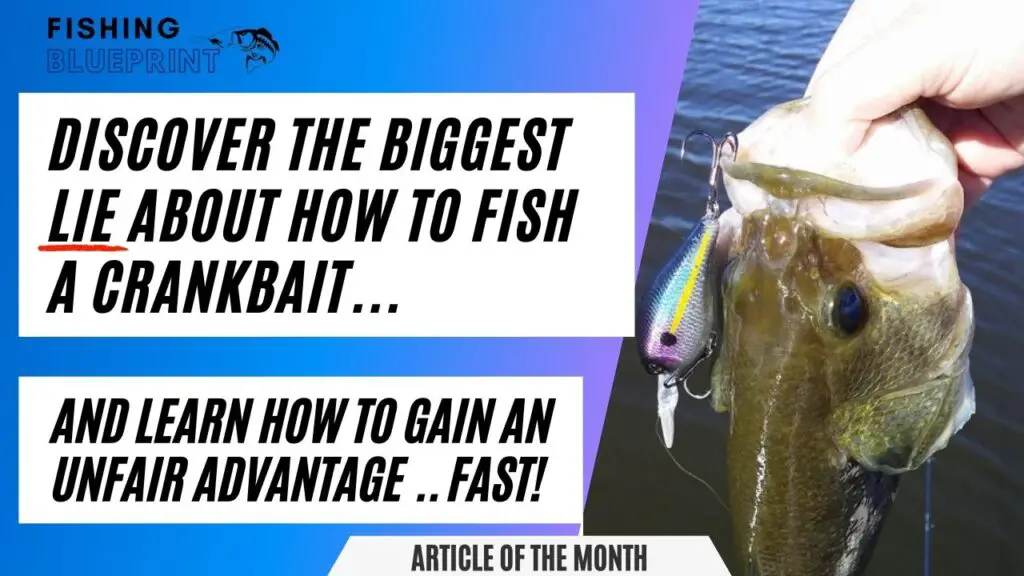How To Fish Lake Skinner
Lake Skinner Fishing Report
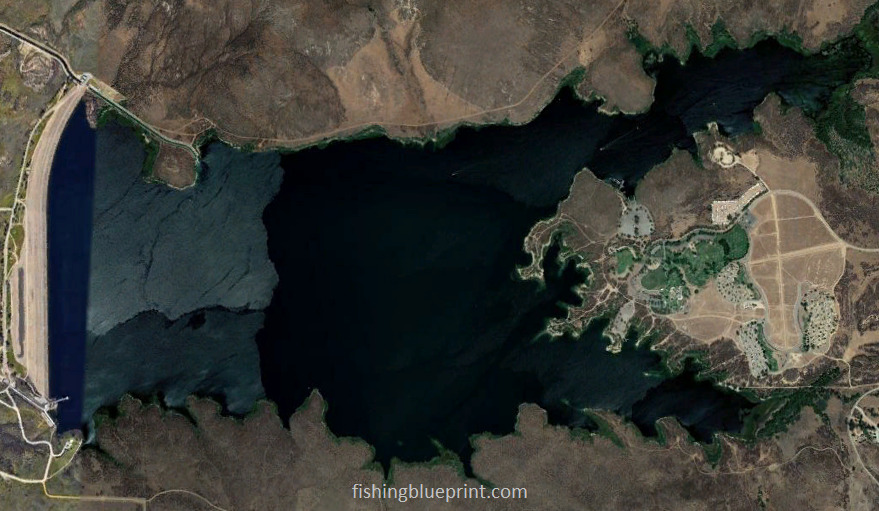
Lake Skinner (officially known as Skinner Reservoir) is a small lake that sits outside Los Angeles.
Overall it’s a popular weekend getaway lake known for its striped bass and largemouth bass fishing. In the winter rainbow trout are planted in the lake as well.
So what are the best tips for fishing Lake Skinner? There are three important factors you must know if you want to know how to fish Lake Skinner successfully. First, you need to know what kind of fish is in Lake Skinner. Second, it’s important for you to know which part of the lake each species can be found. Lastly, knowing what are the best baits that work on Lake Skinner is vital. However, tactics, baits, and locations will be different for each type of fish that you target. So let’s talk about the steps you need to take in order to give you the best chance of catching a fish on Lake Skinner.
WARNING: There’s a lot of information about this subject you’ll probably want to come back to. No one expects you to remember all these tips. We know your time is precious, so we really tried to over-deliver in value for you. Additionally, we frequently update reports like this, so you’ll want to stay up to date with any changes or additional tips we include for you.
We found that the easiest way to save and bookmark this report so you can come back to it later is to share it on your favorite social media platform, especially if you use your phone to get important tips like the ones in this report here…
Click on your favorite social media buttons to remember this page now!
About Lake Skinner
Lake Skinner is a shallow body of water with the average depth being 25 feet and a maximum depth of 75 feet when the lake is completely full. Being 2.5 miles long, fishing at Lake Skinner can be amazing when you have 1,400 acres to fish. Skinner Lake gives locals and visitors the opportunity to test their luck in catching one of the many game species this lake has to offer.
Important Lake Warnings
Algae blooms may be present which may affect fishing, swimming, and water contact in general.
According to parks.ca.gov, “every one of California’s new laws requires boat operators to have a California Boating Card. The card is required for anyone under the age of 41 to operate a boat in California’s waters.”
If you are fishing and camping, fire bans may be in effect due to the ongoing drought conditions.
What Kind Of Fish Are In Lake Skinner
- Rainbow Trout
- Largemouth Bass
- Striped Bass
- White and Black Crappie
- Bluegill and Sunfish
- Catfish
Lake Skinner Fishing Tips & General Strategies
It can be a challenge to break down Lake Skinner and decide to get started.
Water Clarity: Clear as a Bell (most of the time anyway)…
- No more fishing in the dark, folks! Lake Skinner boasts some of the best water clarity around.
- Thanks to regular maintenance, expect 6-10 feet of visibility, perfect for sight fishing.
- Pro-tip: Use natural-colored lures to fool those finicky fish.
Lake Skinner’s Fishin’ Structures: A Bass’ Dream Home
- Rocky Reefs: A True Bass Magnet
- Cast your line near these underwater rock formations, and you’re sure to reel in a big one.
- Don’t forget your trusty jigs or creature baits to tempt those bottom dwellers.
- Weeds, Grass, and Hydrilla: Nature’s Bass Bungalows
- Bass love to hide in these lush, green havens.
- Rig up a Texas-rigged worm or flippin’ jig to get through the jungle and snatch that lunker.
- Drop-offs and Ledges: Where the Big Girls Hang Out
- These underwater cliffs are the perfect ambush spot for monster bass.
- Grab your deep-diving crankbaits and football head jigs to tackle these big momas.
- Docks: The Shady Side of Bass Life
- Bass love the cover and shade provided by these man-made structures.
- Make like a ninja and sneak up with a wacky-rigged Senko or finesse jig for some dock-skippin’ action.
- Be warned: these bass might be a little pier-pressured, but patience is key.
Springtime Fishing update
Air temp:
- Springtime brings mild to warm temps, averaging between 60-75°F. Perfect for a day of fishin’ in comfort!
Wind:
- Wind Speed & Direction: Expect a gentle breeze, with winds typically ranging from 5-15 mph. Look out for southerly or westerly winds, which can really help stir up those bass bites!
Precipitation:
- Occasional rain showers may occur on the lake, but hey, that’s just more water for the fish, right? Plus, those overcast days can make for some reel productive fishing.
Spawners:
- Largemouth bass: These green beauties start their spawning dance when water temps hit the sweet spot of 60-70°F. Most of the time, they make their beds in shallow places with a mix of rocks and gravel. It also helps with some kind of cover nearby, like plants or structures. Some of the best places to look for spawning largies are small coves, flats, and areas near ramps or the handicap beach.
- Striped bass: Striper spawning is a bit trickier, as they prefer a slightly cooler range of 58-65°F. They like moving water or near where water comes into the lake.
Recent Catches:
Anglers have shared stories of catching largemouth bass weighing up to 9lb, striped bass as heavy as 50lb, catfish reaching 30lb, and a variety of panfish. Some reports also mention catching white bass and smaller catfish.
Successful Baits & Lures:
- Largemouth: Darker colored jigs with Yamomoto twin tail trailer has been working. Fishing the drop shot in Aaron’s Magic colors, topwater poppers first thing in the morning has also been working
- Stripers: Catching stripers here never gets old. Casting out your hook with cut sardine, nightcrawlers, end even liver has been working. Topwater lures have also been working such as poppers and walking baits like spooks.
Hotspots:
Key fishing spots mentioned by fellow fishermen include the handicap beach, dam area, shorelines, and coves near ramps. Fish can be found near structures, drop-offs, and other cover, so it’s important to explore these areas thoroughly.
Tactics:
Anglers have had success using different techniques like trolling, working the shorelines, casting from the beach, or targeting specific structures. It’s crucial to adapt your approach based on the current conditions and fish behavior.
Lake Skinner – Summer Fishing update
Hay-o, fellow anglers!
After reading the reports from the groups and forums here is what to expect if you’re headed out the lake:
Reports from fellow anglers, summer weather at Lake Skinner is in full swing. Expect hot temps ranging from 85-100°F. Winds have been pretty gentle to moderate, around 5-15 mph, and coming from the southwest or west.
The summertime water temperature during the summer usually ranges from 75-85°F.
Both bass and stripers have been feeding primarily on shad.
However bass has also been noted to target bluegill, crayfish, frogs, birds, and snakes!
Both bass are most active and hunting in shallow waters near cover during the early morning and late afternoon hours.
Fellow anglers advise keeping an eye out for schools of baitfish being chased by stripers in open water or near the surface.
So… what’s working?
Check out what other fellow anglers recommend for catching largemouth bass and striped bass at Lake Skinner during the summer:
Largemouth Bass:
- Topwater Baits: Early morning or late afternoon is the best prime time for topwater baits. Lures like buzzbaits and frogs near cover, and walking baits out in open water. Use a steady retrieve or a “walk-the-dog” to hook into bass hiding in cover.
- Jigs and Texas Rigs: In deeper water or near structure, try fishing with jigs or Texas rigs rigged with soft plastics in dark or purple hues. Slowly crawl either one of these baits along the bottom and be ready for a sudden strike.
- Crankbaits: For more active bass, crankbaits can be a good option. This is also a good choice if you’re fishing rocky banks. Lipless crankbaits have been working well around grass.
Striped Bass:
- Live Bait: The tried-and-true method for catching stripers is with live bait. It has been commonplace to use shad, anchovies, or other small baitfish. Rig them up on a Carolina rig or drop shot rig and let them drift near structure or in moving water.
- Spoons: Chrome or silver spoons can mimic the flash and twink of shad and cal in stripers in open water. Cast out your spoon and jerk it up quickly, then slowly follow it down with your rod tip.
- Swimbaits: Big swimbaits like the Huddleston or S-Waver can also monster stripers here. Scan, find, and fish stripers around deep structures.
Common Baits for Bass Fishing in Summer:
- Reaction Baits: Topwater poppers, crankbaits, and spinnerbaits (brands like Zoom, Strike King, and Rapala)
- Finesse Baits: Drop shot rigs, finesse worms, and shaky head jigs (brands like Roboworm, Yamamoto, and Berkley)
Specific Locations for Largemouth Bass:
- Handicap Beach
- Domenigoni Flats
- South Shoreline
- Ramp 1 Cove
- Ramp 2 Cove
Specific Locations for Striped Bass:
- Dam Area
- Skinner Island
- Inflows from Tucalota Creek
- East End of Lake
- Middle of Lake near Drop-Offs
But Where Are The Best Places To Fish At Lake Skinner?
And in no particular order here is that list of the best fishing spots at Lake Skinner.
DISCLAIMER: The material provided is for general information purposes only. It’s important to understand that any information provided in this article can change at any time. Any maps or graphics featured are not to be used as navigational aids. Fishing Blueprint will not be responsible for any personal injury or property damage from any misuse of the maps or graphics provided. It’s completely impossible to give you every single spot where you can potentially catch a fish. But, what this list does do is to give you a helping hand and narrow down to the most productive fishing spots.
South Shore - Toilet Cove To Boat Bouys
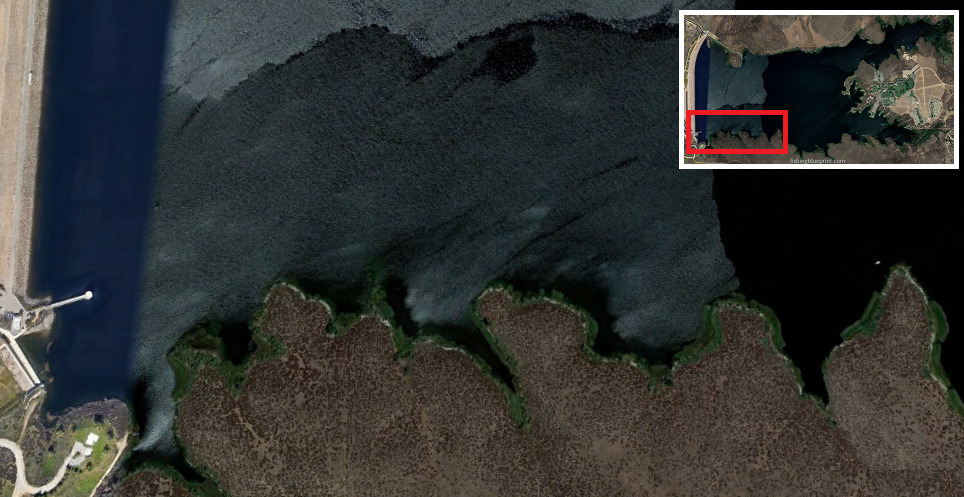
But look closer…

If you’re targeting striped bass, then you have to check out this area.
Schools of striped bass will suspend around the river channel ledge and multiple points this area offers.
The secret to effective striper fishing is using high-quality fish sonar to find where the bass are holding. Often it’s easier to find the school of baitfish first, then you’ll often see striped bass nearby
Below, I included a primer-blueprint to help you quickly and easily get started with stripped bass fishing even if you did it before. Ready? Here we go…
If it’s windy, stormy, or if the stripers are actively feeding:
- Consider casting or trolling white or silver lipless crankbaits, silver spoons, big inline spinners, hard plastic minnow-style jointed swimbaits, and umbrella rigs work really well.
- When the stripers are busting shad on the surface, try walking a topwater walking bait, whopper plopper, or an umbrella rig.
Don’t forget – in windy conditions you can slow your drift using a drift sock for slowing your boat down without having to drain your battery.
In calm conditions, or if the bass are not active you have a few options to target:
- Consider dropping cut frozen anchovies down to where the bass are holding in open water
- Jig a flutter spoon over the school to get them activated
- Swim or jig a bucktail hair jig over or through the school
- Swim or jig a finesse 4″ soft plastic swimbait through or over the school
Have a bright-colored crankbait ready if the striped bass dive when the boat approaches the boil; one of these tactics should deliver at least a couple of good fish.
Lastly, do you want to escape the heat? In the evenings, anchor off of points and fish deep with cut frozen or fresh anchovies. Works best when you use a green light to attract the baitfish!
Located: southside near the dam end.
Structural features: Submerged river channel, ledges, points, sparse artificial structure.
Best species to target: Striped bass, largemouth bass, smallmouth bass, crappie
Most effective way to fish this spot: Boat, kayak, float tube
Inlet Area
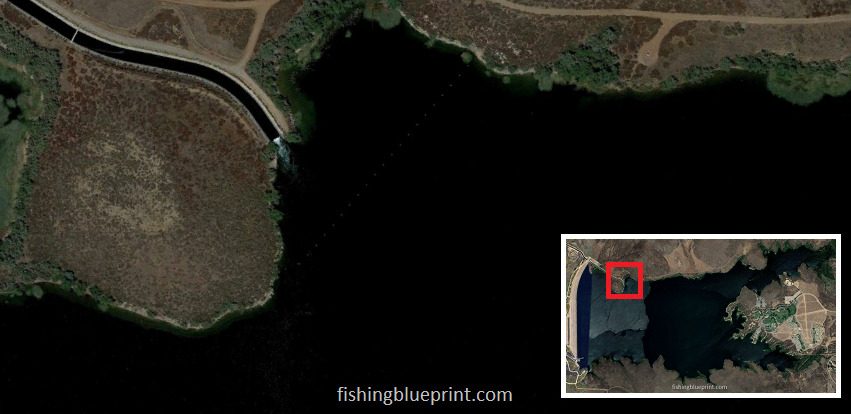
This area is a water inlet flowing into the lake.
Anytime you observe an area with a constant supply of current it should be checked for fish. The flowing water into the area brings nutrients and food for the local baitfish to eat. Naturally, the bass will follow the baitfish and pick off the sick or injured in this area.
Another important feature about this area is since it provides a constant flow of current and swirling water, it subsequently provides a constant source of oxygen. If there is a constant source of oxygen, it means the area is less likely to be affected by severe weather or seasonal changes (ex: the fall turnover) and it will attract fish all year long.
You’ll notice the locals lining the boats up along the boat boundary buoys and casting large swimbaits and umbrella rigs upstream.
Here is a list of lures that can work great in this area: topwater lures, buzzbaits, spinnerbaits, crankbaits, umbrella rigs, jerkbaits, chatterbaits, swim jigs, hair jigs, and underspin jigs.
Located: northside near the dam end.
Structural features: Inlet of flowing water.
Best species to target: Striped bass, largemouth bass, crappie
Most effective way to fish this spot: Boat, kayak, float tube
The Ridge

But look closer…
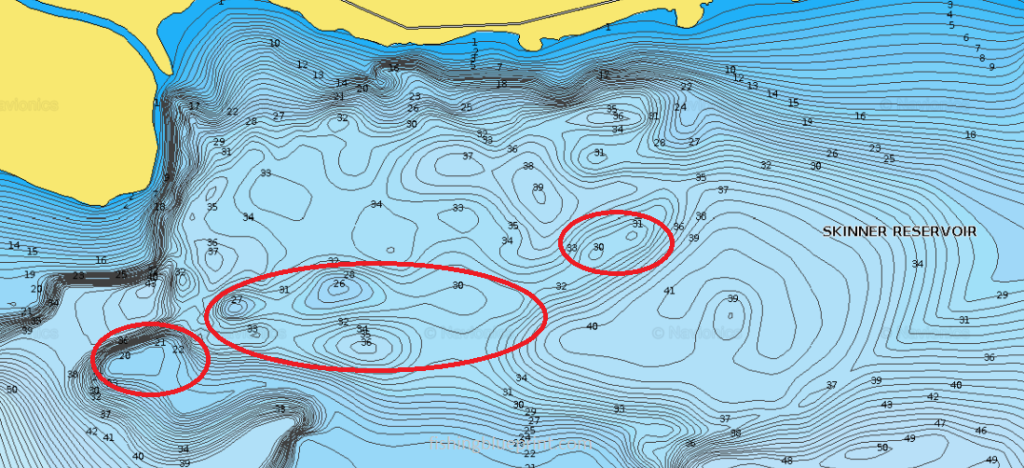
This area is great because it’s a man-made ridge made from concrete and chunk rock. This main lake spot will also hold striped bass and largemouth bass year-round.
It’s wise to scan the entire ridge because fish will migrate to different sections of the ridge.
A little-known fact about this area is it can produce a great early morning topwater bite.
Here’s a list of effective baits and techniques you can use in this area:
Calm or post-frontal conditions: Senkos, drop shot rig, tubes, Neko rig, football jigs
Windy, pre-frontal: topwater lures, buzzbaits, spinnerbaits, crankbaits, umbrella rigs, jerkbaits, chatterbaits, swim jigs, hair jigs, and underspin jigs.
Located: northside near the dam end.
Structural features: man-made ridge
Best species to target: Striped bass, largemouth bass, crappie
Most effective way to fish this spot: Boat, kayak, float tube
North Bay
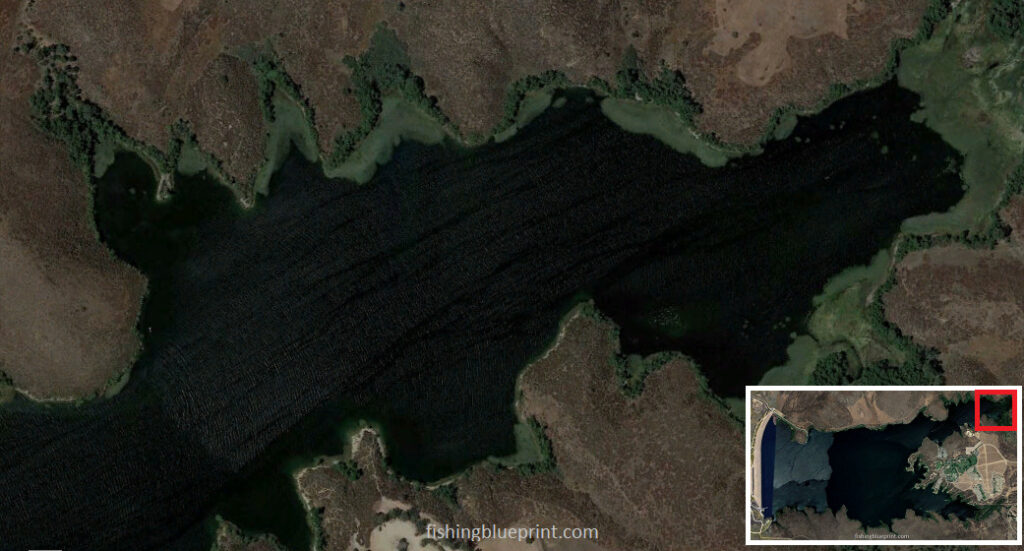
This large spot is the opening to a large grass cove, and there are two main ways to fish there.
First, you can start by looking for important fish-holding structures like channel swings, drop offs, and deep points.
Next, try to figure out if the structure is near any secondary cover, such as brush piles, boulders, rock piles, vertical timber, submerged weeds, or an artificial habitat.
Third, check to see if there are any baitfish in the area.
If there is, it’s likely that a bass is close, so you might want to try fishing there.
It’s important to keep going if you don’t see any secondary cover or baitfish in the area you’re looking at. Don’t bother with this place. You can always do it again in the future.
Also, if you see a single brush pile, laydown, or upright tree, there’s a good chance that it has a few fish in it.
The second way to fish in this area is to focus on fishing in the plants.
It’s a pretty big place that doesn’t change much in depth and is full of plants. This plant life can sometimes grow up to the top, making a floating mat or canopy.
When the weeds are just starting to grow or are dying off, this huge flat is a good place to fish because it makes deep pathways in the plants. Bass will hide in holes full of weeds and wait for food there.
It’s not very deep (between 3 and 10 feet), but the fish can hide and make this place their home because of all the cover. Fish can hide in parts of the flat that are close to deep water if they feel like they are being chased. When you fish on the outside edges, you can often catch fish.
Here’s a list of effective baits and techniques you can use in this area:
Calm or post-frontal conditions: Senkos, drop shot rig, tubes, Neko rig, football jigs
Windy, pre-frontal, summer conditions: topwater lures, buzzbaits, spinnerbaits, crankbaits, umbrella rigs, jerkbaits, chatterbaits, swim jigs, hair jigs, and underspin jigs.
Artificial habitat/structure: drop shot rig, crankbaits, Neko rig, wacky worm
Grass/ reeds/ tulles: frog lures, flipping lures, heavy vegetation punching, Texas rigged Senko, Mojo rig. In submerged grass; drop shot rig, soft plastic swimbaits, swim jigs, crankbaits, lipless crankbaits all work great!
Rocks, points, cuts: crankbaits, jigs, Texas rigs, and Carolina rigs
Unfortunately, there is no night fishing at Lake Skinner.
Anchoring over the points near the inlet and fishing the deep channels are great for catching catfish and crappie.
Located: northeast
Structural features: channel swings, drop offs, deep points, vegetation, tullies
Best species to target: Striped bass, largemouth bass, crappie, trout
Most effective way to fish this spot: Boat, kayak, float tube
Social Security Cove
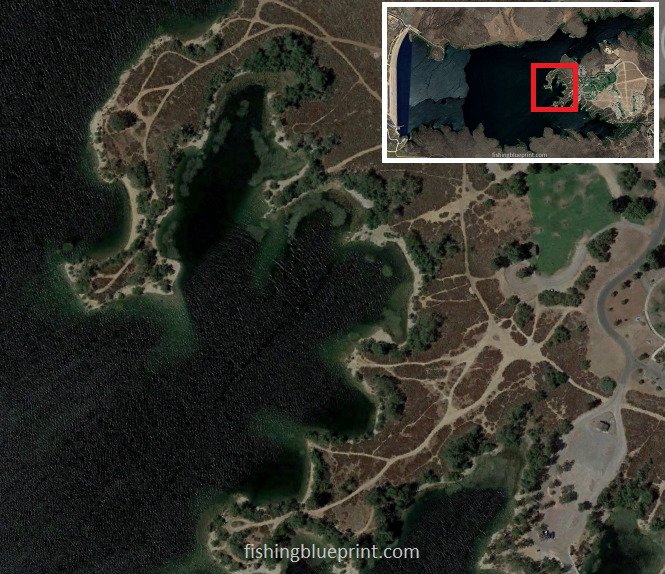
This place is a protected cove with many points, ledges, hills, drop-offs, and humps. This means you have many different objects you can target and fish.
The most productive basic structures are the main lake points, channels and ditches. Look for rock piles, high spots and ridges that are close to these main structures.
During the spring spawn, the back of the cove is a great place to be.
Before you try to fish everything, make sure you take some time to check these areas with your fish finder to see if there are any bait fish or bass there. If there is food or bass in the area, you should fish there.
Calm or post-frontal conditions: Senkos, drop shot rig, tubes, Neko rig, football jigs, and Carolina rigs.
Windy, pre-frontal: topwater lures, buzzbaits, spinnerbaits, crankbaits, lipless crankbaits, jerkbaits, umbrella rigs, soft plastic swimbaits, swim jigs, chatterbaits, frog lures, underspin jigs, and hair jigs.
Located: midlake east side
Structural features: sheltered cove with multiple points, ledges, ridges, drop offs, and humps
Best species to target: Striped bass, largemouth bass, crappie, trout
Most effective way to fish this spot: Boat, kayak, float tube
South Bay
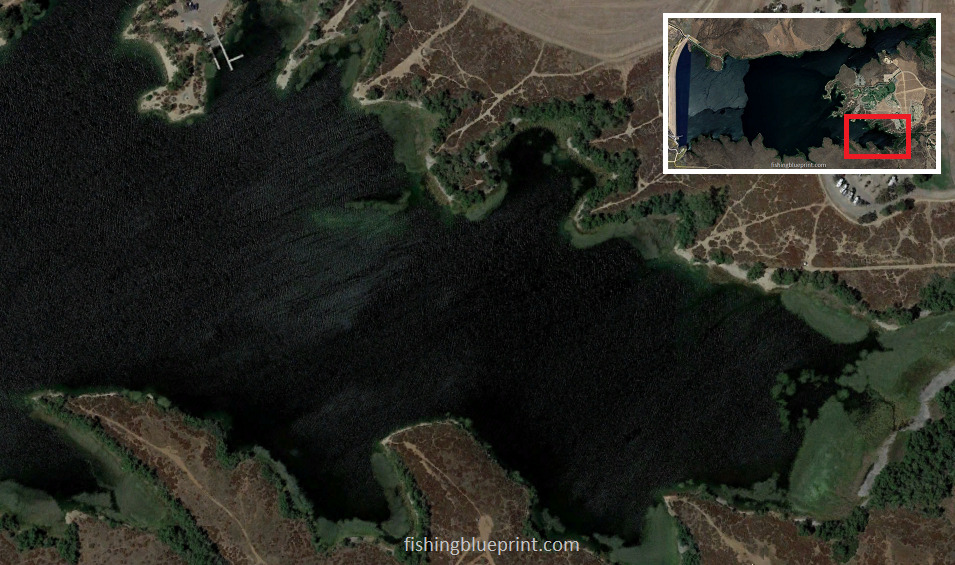
But look closer…
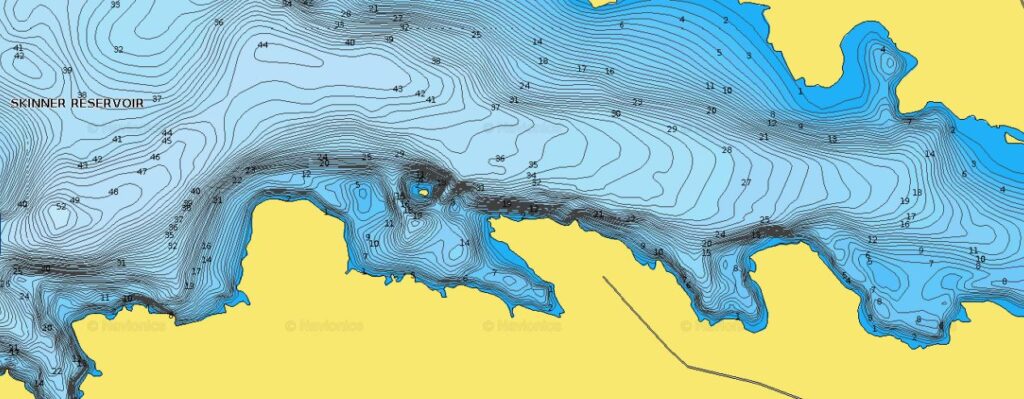
South Bay is great if you enjoy fishing vegetation.
It’s a pretty big place that doesn’t change much in depth and is full of vegetation.
The shores are lined with tulles, and as you go deeper into the cove, you’ll see more and more grass mats that are both buried and floating.
Most fisherman like to fish on the north side of this bay, which is especially good in the spring and summer.
The south shore has steep rocky banks, rocks, and drop offs that are great for fishing in the summer and winter.
Here’s a list of effective baits and techniques you can use in this area:
Calm or post-frontal conditions: Senkos, drop shot rig, tubes, Neko rig, football jigs
Windy, pre-frontal, summer conditions: topwater lures, buzzbaits, spinnerbaits, crankbaits, umbrella rigs, jerkbaits, chatterbaits, swim jigs, hair jigs, and underspin jigs.
Artificial habitat/structure: drop shot rig, crankbaits, Neko rig, wacky worm
Grass/ reeds/ tulles: frog lures, flipping lures, heavy vegetation punching, Texas rigged Senko, Mojo rig. In submerged grass; drop shot rig, soft plastic swimbaits, swim jigs, crankbaits, lipless crankbaits all work great!
Rocks, points, cuts: crankbaits, jigs, Texas rigs, and Carolina rigs
Unfortunately, there is no night fishing at Lake Skinner.
Anchoring over the points near the inlet and fishing the deep channels are great for catching stripers, trout, catfish and crappie.
Located: southeast
Structural features: channel swings, drop offs, deep points, vegetation, tullies
Best species to target: Striped bass, largemouth bass, crappie, trout
Most effective way to fish this spot: Boat, kayak, float tube
Boat Ramps at Lake Skinner
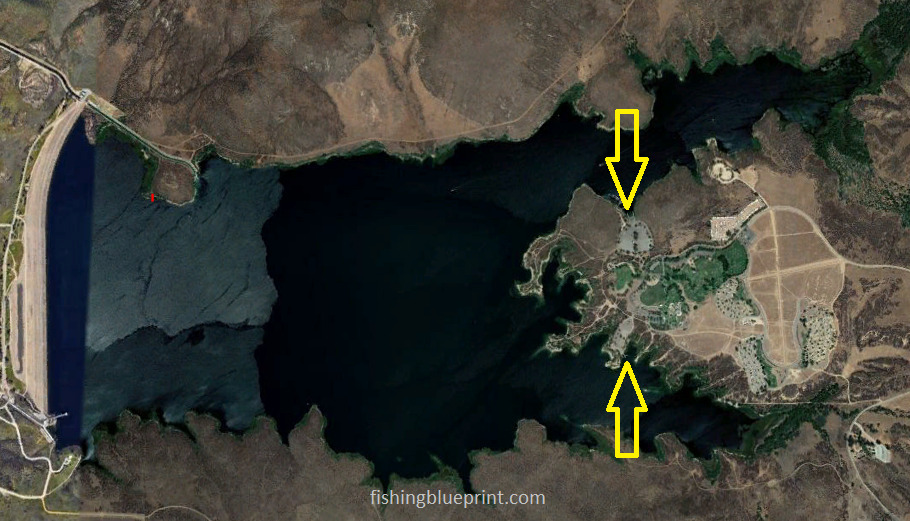
Lake Skinner Fees
Boat Launch: $7
Camping: $30-50 per night
Day use: $6 per adult | $3 per child (12 and younger)
Fishing: $10 per adult – per day
$8 per child (12 and younger) – per day
Pets: $2 each, per day
Sewage Dump Fee: (non-camper): $20
Lake Skinner North Boat Ramp
Location: north side of Lake Skinner Recreation Area
37701 Warren Rd, Winchester, CA 92596
dfg.ca.gov
(951) 926-1505
Lanes: 5
Restrooms: Yes
Showers: no
Gas: No
Camping nearby: Yes
Lake Skinner South Boat Ramp
Location: south side of Lake Skinner Recreation Area
37701 Warren Rd, Winchester, CA 92596
dfg.ca.gov
(951) 926-1505
Lanes: 2
Restrooms: Yes
Showers: no
Gas: No
Camping nearby: Yes
Tackle Shops Near Lake Skinner
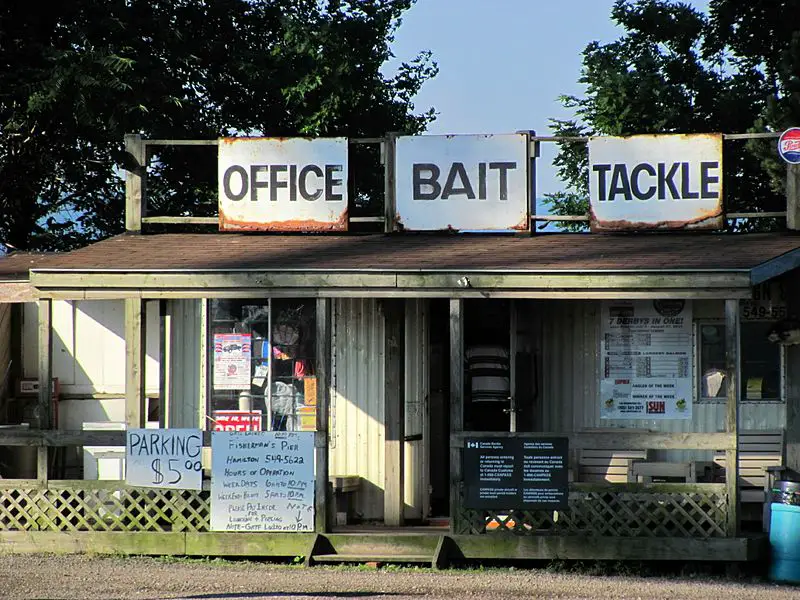
Camp Store at Lake Skinner
37701 Warren Road, Winchester, CA 92596
(951) 926-1541
Nearby boat ramp: Yes
Groceries available: Yes
Gas: No
Bathrooms: Yes
Showers: No
Camping nearby: Yes
Lakeside Market
4164 N Perris Blvd a, Perris, CA 92571
(951) 943-4364
Last Chance Bait & Tackle
3356 Wentworth Dr, Hemet, CA 92545
lastchancetackle.com
(951) 658-7410
Frank’s Bait & Tackle
12142 California St, Yucaipa, CA 92399
buyfrankstackle.com
(909) 855-2911
Sportsman’s Warehouse
2585 Tuscany St, Corona, CA 92881
stores.sportsmans.com
(951) 382-7100
Camping Near Lake Skinner
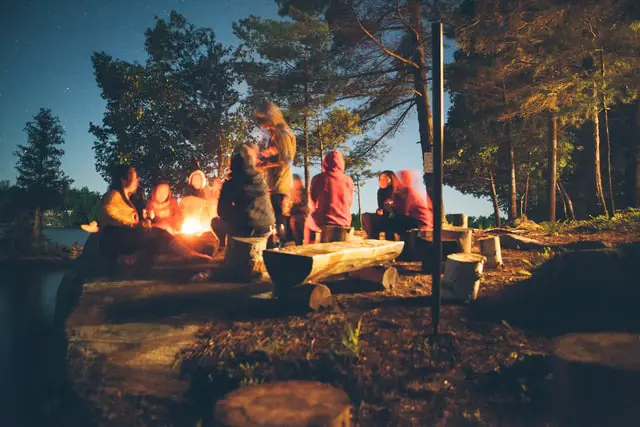
Lake Skinner Recreation Area & Campgrounds
- Sites – 380 total separated into 3 campgrounds
- RVs welcome. Full and partial hookups available
- Standard sites/ tent sites available
- 28-day stay sites: available
- Handicap sites available
- Camp store available: Yes
- Dump station available: Yes
- Low season: October – March
- High season: April – September
- Pets welcome: Yes
- Boat ramp nearby: Yes
- Boat rentals available: Yes
- Fire ring: Yes
- Grill: Yes
- Drinking water: Yes
- Coin operated showers: Yes
- Flush toilets: Yes
- Hiking trails: Yes
- Biking Trails: Yes
- Link for campground map – here
Other California Related Fishing Articles
- Bass Lake Fishing Report
- Clear Lake Fishing Report
- Castaic Lake Fishing Report
- California Delta Fishing Report
- Diamond Valley Lake Fishing Report
- Don Pedro Reservoir Fishing Report
- Eagle Lake Fishing Report
- El Capitan Reservoir Fishing Report
- Lake Berryessa Fishing Report
- Big Bear Lake Fishing Report
- Folsom Lake Fishing Report
- Irvine Lake Fishing Report
- Lake Almanor Fishing Report
- Lake Camanche Fishing Report
- Lake Isabella Fishing Report
- Lake Havasu Fishing Report
- Lake McClure Fishing Report
- Lake Oroville Fishing Report
- Lake Perris Fishing Report
- Lake Piru Fishing Report
- Lake Skinner Fishing Report
- Lake Tahoe Fishing Report
- Los Banos Reservoir Fishing Report
- New Hogan Lake Fishing Report
- New Melones Lake Fishing Report
- O’Neill Forebay Fishing Report
- Pardee Lake Fishing Report
- Pyramid Lake Fishing Report
- San Luis Reservoir Fishing Report
- San Vicente Reservoir Fishing Report
- Shasta Lake Fishing Report
- Silverwood Lake Fishing Report
- Trinity Lake Fishing Report
- Whiskeytown Lake Fishing Report
More articles just for you...
Selecting Early Summer Bass Fishing Lures [Avoid 5 Common Mistakes]
A Complete Buyer’s Blueprint On The Best Early Summer Bass Lures On The Market Today! When it comes to bass fishing, choosing the right lure
Early Summer Bass Fishing [Avoid These 3 Sneaky Lies]
Learn these closely guarded secrets early summer bass fishing … and… dramatically boost your advantage over other anglers! Late spring to early summer bass fishing
Fear The Finesse? 7 Ned Rig Fishing Secrets Exposed!
Conquer the Fear of Finesse… and… Unlock the Potential Ned Rig Fishing – TODAY! Fellow Angler… Like most of you I’m pretty set in my
Fishing Spawning Bass [18+ Lures & Gear]
Get Ready For The Spawn Now When bed fishing, stealth is of the biggest essential tip. Instead of racing forward with a trolling motor, anglers
[2024 Editors Choice] Picking The Best Bass Fishing LINE For ANY Budget
What is the best bass fishing line? | What is a good fishing line for bass? The best type of bass fishing line is based
Drift Sock Basics – What It Is A Drift Sock & How To Use It [2024 Quick Start Guide]
What Does A Drift Sock Do? | Why Use A Drift Sock? photo cred: WLUK We’ve ALL been there… you work your butt off the



